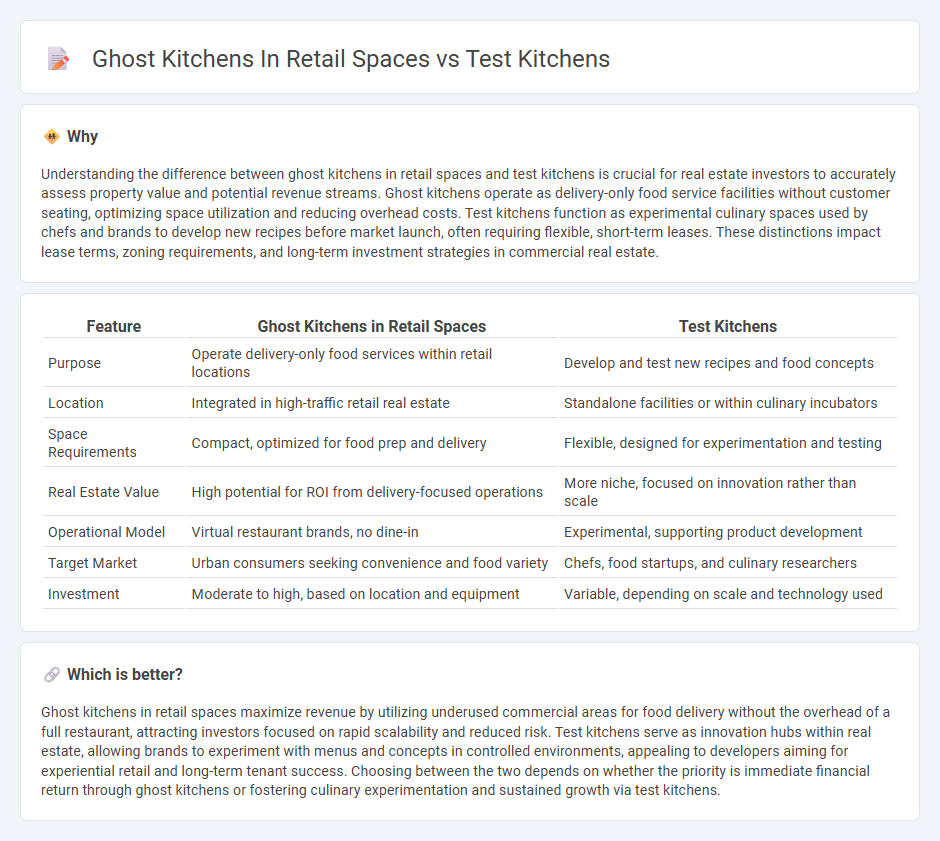
Ghost kitchens in retail spaces optimize underutilized commercial areas by offering delivery-only food services, reducing overhead costs compared to traditional setups. Test kitchens serve as innovation hubs within retail environments, allowing culinary brands to experiment with recipes and gather consumer feedback before full-scale launches. Explore how integrating ghost and test kitchens into real estate strategies can maximize property value and operational efficiency.
Why it is important
Understanding the difference between ghost kitchens in retail spaces and test kitchens is crucial for real estate investors to accurately assess property value and potential revenue streams. Ghost kitchens operate as delivery-only food service facilities without customer seating, optimizing space utilization and reducing overhead costs. Test kitchens function as experimental culinary spaces used by chefs and brands to develop new recipes before market launch, often requiring flexible, short-term leases. These distinctions impact lease terms, zoning requirements, and long-term investment strategies in commercial real estate.
Comparison Table
| Feature | Ghost Kitchens in Retail Spaces | Test Kitchens |
|---|---|---|
| Purpose | Operate delivery-only food services within retail locations | Develop and test new recipes and food concepts |
| Location | Integrated in high-traffic retail real estate | Standalone facilities or within culinary incubators |
| Space Requirements | Compact, optimized for food prep and delivery | Flexible, designed for experimentation and testing |
| Real Estate Value | High potential for ROI from delivery-focused operations | More niche, focused on innovation rather than scale |
| Operational Model | Virtual restaurant brands, no dine-in | Experimental, supporting product development |
| Target Market | Urban consumers seeking convenience and food variety | Chefs, food startups, and culinary researchers |
| Investment | Moderate to high, based on location and equipment | Variable, depending on scale and technology used |
Which is better?
Ghost kitchens in retail spaces maximize revenue by utilizing underused commercial areas for food delivery without the overhead of a full restaurant, attracting investors focused on rapid scalability and reduced risk. Test kitchens serve as innovation hubs within real estate, allowing brands to experiment with menus and concepts in controlled environments, appealing to developers aiming for experiential retail and long-term tenant success. Choosing between the two depends on whether the priority is immediate financial return through ghost kitchens or fostering culinary experimentation and sustained growth via test kitchens.
Connection
Ghost kitchens in retail spaces optimize real estate by transforming underutilized areas into profit-generating food preparation zones without traditional dining setups. Test kitchens leverage these flexible spaces to experiment with new culinary concepts, reducing overhead costs and accelerating product development cycles. Both models capitalize on strategic location data and market demand metrics to maximize spatial efficiency and drive innovative food service solutions within commercial real estate.
Key Terms
Commercial Leasing
Test kitchens and ghost kitchens differ significantly in their commercial leasing requirements within retail spaces, where test kitchens demand flexible leases due to their experimental nature and frequent layout changes. Ghost kitchens capitalize on streamlined, cost-efficient leases emphasizing location accessibility and delivery logistics without the need for customer-facing areas. Explore the complexities of leasing agreements tailored to both concepts to optimize operational efficiency and retail success.
Tenant Improvements
Test kitchens in retail spaces require extensive tenant improvements including specialized ventilation, equipment installation, and space customization to accommodate recipe development and product testing. Ghost kitchens prioritize efficient layout design and HVAC upgrades to support high-volume food preparation for delivery without customer-facing amenities. Explore detailed strategies for optimizing tenant improvements in both kitchen models to maximize operational efficiency and ROI.
Zoning Regulations
Test kitchens and ghost kitchens in retail spaces face distinct zoning regulations that impact their operation and location. Test kitchens often require permits aligned with food production and retail use, while ghost kitchens may fall under commercial food service or industrial zoning depending on delivery-only service models. Explore zoning specifics to optimize kitchen placement and compliance in your retail strategy.
Source and External Links
What it's Like to Work in a Test Kitchen - Provides an inside look at the operations and challenges of working in a test kitchen environment.
Test Kitchen - Describes what a test kitchen is and its role in food development, often run by large food companies or individuals.
America's Test Kitchen - A popular cooking show based in a real test kitchen, known for its rigorous recipe testing and culinary expertise.
 dowidth.com
dowidth.com